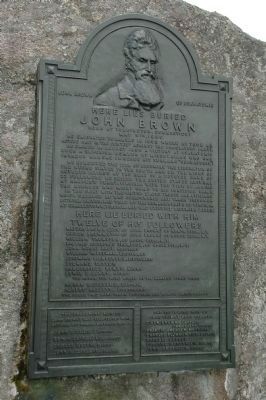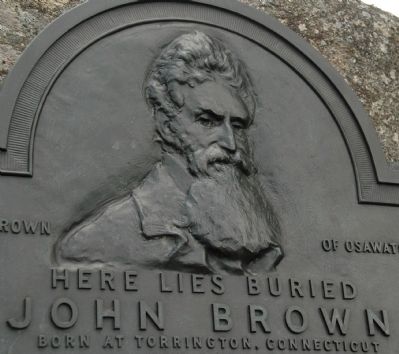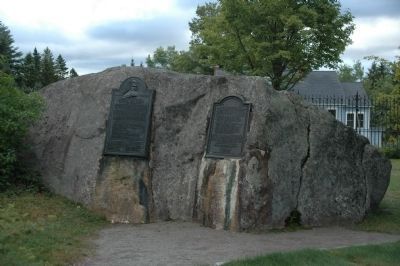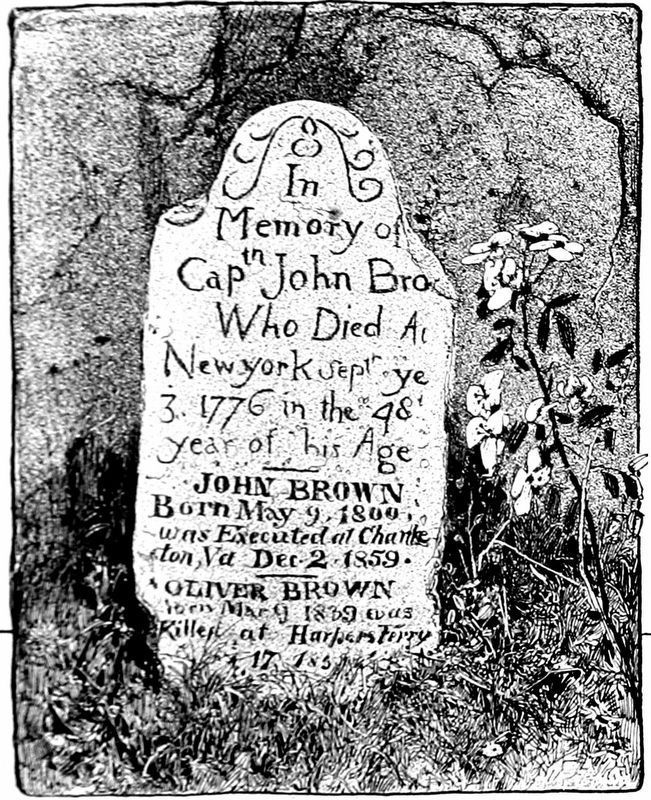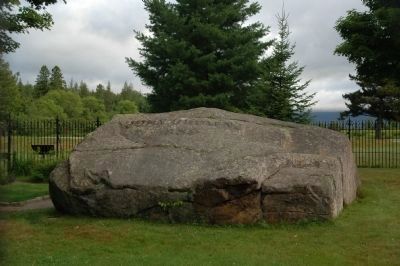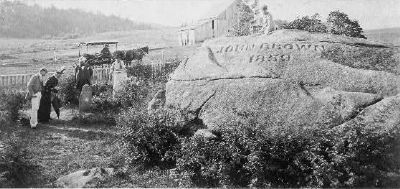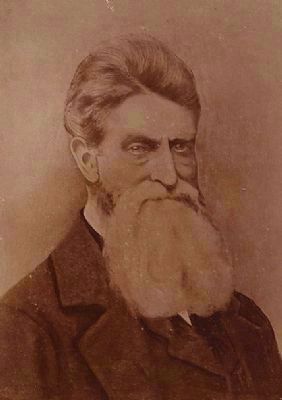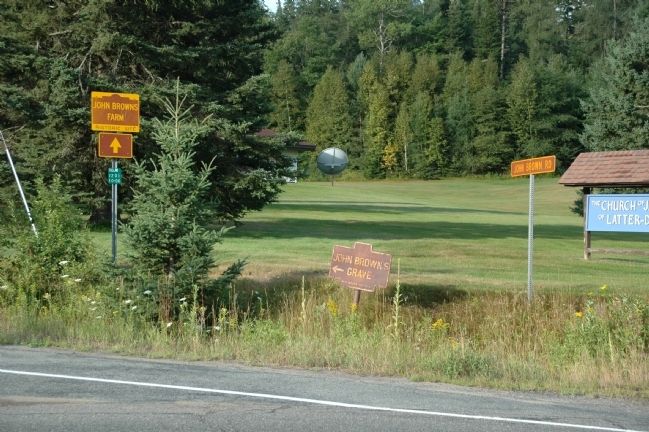North Elba in Essex County, New York — The American Northeast (Mid-Atlantic)
Here Lies Buried John Brown
Here Lies Buried
John Brown
Born at Torrington, Connecticut
May 9th, 1800
He conceived the idea of becoming a liberator of the negro slaves in the south and on the night of October 16, 1859 at the head of a devoted band of 22 followers he seized the United States Arsenal at Harper's Ferry, Virginia with the view of arming the negroes who might come to his fortified camp. In the fight with United States troops and civilians which followed he was overpowered and taken prisoner October 18, 1859, was tried by the commonwealth of Virginia at Charlestown, Virginia and executed December 2, 1859.
Twelve of His Followers
Watson Brown (Son of John Brown) of North Elba, N.Y.
Oliver Brown (Son of John Brown) of North Elba, N.Y.
William Thompson, of North Elba, N.Y.
Dauphin Adolphus Thompson, of North Elba, N.Y.
John Henri Kagi, Adjutant
William H. Leeman, Lieutenant
Jeremiah G. Anderson, Lieutenant
Steward Taylor
Dangerfield Newby, Negro
Lewis S. Leary, Negro
The above ten were killed at the Harper's Ferry Fight
Aaron D. Stevens, Captain
Albert Hazlett, Lieutenant
The above two were taken prisoners and hanged March 16, 1860
The following men of John Brown's band escaped, but were captured and hanged December 16, 1859,
John E. Cook, Captain
Edwin Coppoc, Lieutenant
Shields Green, Negro
John A. Copeland, Negro
The following men of John Brown's band escaped.
Owen Brown, Captain (Son of John Brown)
Francis Jackson Merriam
Charles Plummer Tidd, Captain
Barclay Coppoc
Osborne P. Anderson, Negro
John Anderson, Negro
Erected 1916 by Byron B. Brewster. Marker states," This tablet erected through the efforts of Byron B. Brewster of Lake Placid, NY.".
Topics. This historical marker is listed in these topic lists: Abolition & Underground RR • African Americans • Cemeteries & Burial Sites. A significant historical date for this entry is March 16, 1859.
Location. 44° 15.121′ N, 73° 58.27′ W. Marker is in North Elba, New York, in Essex County. Marker can be reached from John Brown Road, half a mile south of New York State Route 73, on the right. The marker is within John Brown Farm State Historic Site, off the loop at the end of John Brown Road. There is an iron fence around the small cemetery where the marker is mounted on a large stone. Touch for map. Marker is at or near this postal address: 115 John Brown Road, Lake Placid NY 12946, United States of America. Touch for directions.
Other nearby markers. At least 8 other markers are within 9 miles of this marker, measured as the crow flies. The XIII Winter Olympic Games (approx. 0.8 miles away); John Brown (approx. 1.3 miles away); Sonja Henie Ice Fountain (approx. 2.3 miles away); Henry J. Kaiser (approx. 2.7 miles away); Mt. Van Hoevenberg Olympic Bobsled Run (approx. 3.6 miles away); Henry Van Hoevenberg (approx. 4.9 miles away); New York State Forest Preserve (approx. 4.9 miles away); New York World War Veterans Memorial Highway (approx. 8.6 miles away). Touch for a list and map of all markers in North Elba.
More about this marker. The marker is in North Elba, which is just south of the Village of Lake Placid.
Also see . . .
1. John Brown 1800 - 1859. PBS People & Events website entry (Submitted on August 26, 2011, by Howard C. Ohlhous of Duanesburg, New York.)
2. History of the Song, "John Brown's Body". American Experience website entry (Submitted on August 27, 2011, by Howard C. Ohlhous of Duanesburg, New York.)
3. John Brown's raid on Harpers Ferry. Wikipedia entry (Submitted on November 11, 2020, by Michael Herrick of Southbury, Connecticut.)
Additional commentary.
1. John Browns Statement at Sentencing
"Now, if it is deemed necessary that I should forfeit my life for the furtherance of the ends of justice, and mingle my blood further with the blood of millions in this slave country whose rights are disregarded by wicked, cruel, and unjust enactments, I say, let it be done."
--John Brown, statement at his sentencing on November, 2, 1859
— Submitted August 26, 2011, by Howard C. Ohlhous of Duanesburg, New York.
2. The Song, "John Brown's Body"
The Song, "John Brown's Body" is an American marching song about the abolitionist John Brown. The song was popular in the Union during the American Civil War:
Old John Brown's body lies a-mouldering in the grave,
While weep the sons of bondage whom he ventured all to save;
But though he lost his life in struggling for the slave,
His truth is marching on.
Chorus:
Glory, Glory, Hallelujah!
His truth is marching on!
John Brown was a hero, undaunted, true and brave;
Kansas knew his valor when he fought her rights to save;
And now though the grass grows green above his grave,
His truth is marching on.
Chorus
He captured Harpers Ferry with his nineteen men so few,
And
he frightened "Old Virginny" till she trembled through and through,
They hung him for a traitor, themselves a traitor crew,
But his truth is marching on.
Chorus
John Brown was John the Baptist for the Christ we are to see,
Christ who of the bondsman shall the Liberator be;
And soon throughout the sunny South the slaves shall all be free.
For his truth is marching on.
Chorus
The conflict that he heralded, he looks from heaven to view,
On the army of the Union with its flag, red, white, and blue,
And heaven shall ring with anthems o'er the deeds they mean to do,
For his truth is marching on.
Chorus
Oh, soldiers of freedom, then strike while strike you may
The deathblow of oppression in a better time and way;
For the dawn of old John Brown was brightened into day,
And his truth is marching on.
Chorus
John Brown's body lies a-mouldering in the grave,
John Brown's body lies a-mouldering in the grave,
John Brown's body lies a-mouldering in the grave,
But his soul goes marching on.
Chorus:
Glory, Glory, Hallelujah!
Glory, Glory, Hallelujah!
Glory, Glory, Hallelujah!
His soul goes marching on.
He's gone to be a soldier in the Army of the Lord
He's gone to be a soldier in the Army of the Lord
He's gone to be a soldier in the Army of the
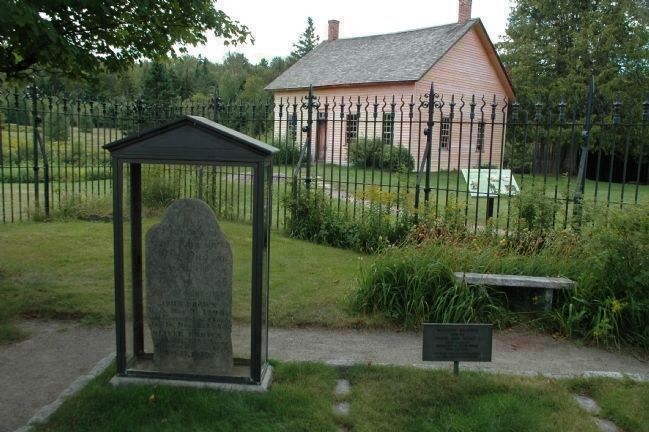
Photographed By Howard C. Ohlhous, August 12, 2011
5. John Brown Head Stone
John Brown was buried here on December 8, 1859, six days after he was hanged for his raid on the Harpers Ferry Arsenal.
The headstone over John Brown's grave, housed in a protective glass case, is inscribed with five names. It was originally carved to
memorialize Brown's grandfather, Captain John Brown, who died in New York while serving in the Continental Army. In the spring
of 1857, Brown had his grandfather's headstone sent from Connecticut to North Elba, adding to it an inscription for his son
Frederick, who had been killed and buried in Kansas. On the morning of Brown's execution in 1859, he directed that three more
names be added to the stone: his own and the names of his sons, Oliver and Watson, who were killed in the raid at Harper's Ferry,
Virginia.
Headstone inscription;
In
Memory of
Captn John Brown
Who Died At
New York Septr Ye
3 1776 in the 48
year of his Age
John Brown
Born, May 9, 1800
was Executed at Charle(s)
ton, Va. Dec. 2, 1859
Oliver Brown
Born Mar. 9,1839, was
Killed at Harper's Ferry
Oct. 17,1859
On the Back:
In memory of
Frederick
son of John & Dianthe Brown
Born Dec.21, 1830, and
murdered at Osawatomie
Kansas, Aug. 3-, 1856
for his adherence to
the cause of freedom
Watson Brown Born Oct.
7,1835, was wound
ed at Harper's Ferry
Oct. 17 & Died Oct.
19, 1859
Headstone inscription;
Memory of
Captn John Brown
Who Died At
New York Septr Ye
3 1776 in the 48
year of his Age
John Brown
Born, May 9, 1800
was Executed at Charle(s)
ton, Va. Dec. 2, 1859
Oliver Brown
Born Mar. 9,1839, was
Killed at Harper's Ferry
Oct. 17,1859
On the Back:
In memory of
Frederick
son of John & Dianthe Brown
Born Dec.21, 1830, and
murdered at Osawatomie
Kansas, Aug. 3-, 1856
for his adherence to
the cause of freedom
Watson Brown Born Oct.
7,1835, was wound
ed at Harper's Ferry
Oct. 17 & Died Oct.
19, 1859
His soul goes marching on.
Chorus
John Brown's knapsack is strapped upon his back
John Brown's knapsack is strapped upon his back
John Brown's knapsack is strapped upon his back
His soul goes marching on.
Chorus
John Brown died that the slaves might be free
John Brown died that the slaves might be free
John Brown died that the slaves might be free
But his soul goes marching on.
Chorus
The stars above in Heaven now are looking kindly down
The stars above in Heaven now are looking kindly down
The stars above in Heaven now are looking kindly down
On the grave of old Jo
hn Brown.
Chorus
— Submitted August 27, 2011, by Howard C. Ohlhous of Duanesburg, New York.
3. Brown's collaborators and what happened to their bodies
The story of John Brown's collaborators and what happened to their remains is complicated. One name is on the plaque incorrectly: Jeremiah Anderson, whose body was used for anatomical dissection by students at the Winchester Medical School, as were those of Shields Green and John Anthony Copeland Jr. Bodies of all three are lost. In retaliation for this affront, and especially for turning Watson Brown's body into a medical exhibit, labeled "John Brown's son – thus
always with abolitionists", Union troops burned the medical school in 1862.
There have been three burials in three coffins on this site: John Brown, in 1859; Watson Brown, in 1882; the other ten, in a single coffin in 1889.
— Submitted November 5, 2020, by Daniel Eisenberg of Boca Raton, Florida.
Additional keywords. Slavery and abolition Seekers of Freedom
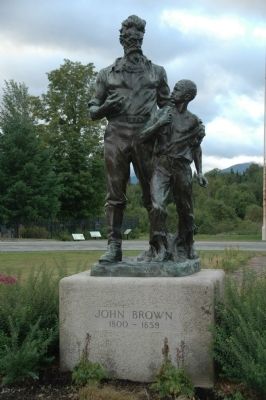
Photographed By Howard C. Ohlhous, August 11, 2011
9. John Brown Monument
The John Brown Memorial Association began making pilgrimages to the John Brown Farm in 1922, commissioning the memorial statue, the work of the New York City sculptor, Joseph Pollia and the Roman Bronze Works, Inc. of Corona, New York. Erected by the Carnes Granite Company of AuSable Forks, New York, it was unveiled on May 9, 1935, and dedicated then "to John Brown and his comrads" by the John Brown Memorial Association, Incorporated. The Association no longer exists.
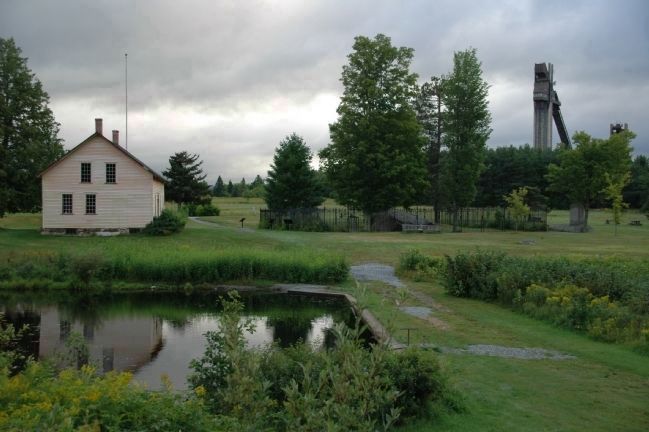
Photographed By Howard C. Ohlhous, August 11, 2011
10. The John Brown Farm - North Elba, NY
The John Brown Memorial Association donated the John Brown Farm to New York State in 1896. The farmhouse, on the left, was restored by the New York State Education Department bewtween 1957 & 1959, and set with period funishings. The John Brown gravesite is in the center, surrounded by a high iron fence. In the distance, on the right, is the 120 meter ski jump tower built for the 1980 Winter Olympic Games in Lake Placid.
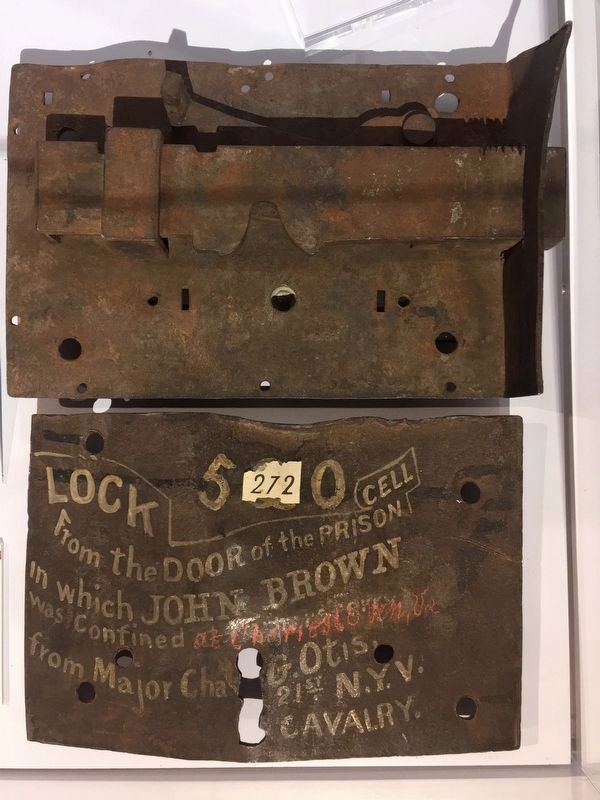
Photographed By Howard C. Ohlhous, October 7, 2023
12. Lock Plate and Lock from John Brown’s Jail Cell, Charles Town, Virginia
During the Civil War Major Charles Otis, of the 21st Cavalry, New York Volunteers, personally removed the lock, and its accompanying plate cover, from the jail cell used to confine the radical abolitionist John Brown in Charles Town, Virginia, from October 18 - December 2, 1859 after the unsuccessful raid upon Harper's Ferry, Virginia, in July 1859. These items are on display at the New York State Military Museum and Veterans Research Center in Saratoga Springs, New York.
Credits. This page was last revised on October 9, 2023. It was originally submitted on August 26, 2011, by Howard C. Ohlhous of Duanesburg, New York. This page has been viewed 2,878 times since then and 113 times this year. It was the Marker of the Week December 2, 2012. Photos: 1, 2, 3. submitted on August 26, 2011, by Howard C. Ohlhous of Duanesburg, New York. 4. submitted on October 11, 2018, by Allen C. Browne of Silver Spring, Maryland. 5. submitted on August 27, 2011, by Howard C. Ohlhous of Duanesburg, New York. 6, 7, 8, 9, 10, 11. submitted on August 26, 2011, by Howard C. Ohlhous of Duanesburg, New York. 12. submitted on October 8, 2023, by Howard C. Ohlhous of Duanesburg, New York. • Bill Pfingsten was the editor who published this page.
